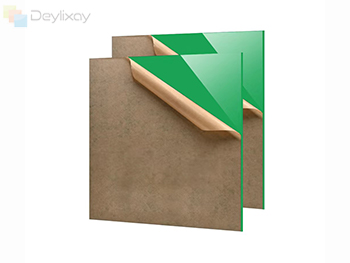जब तपाइँ तपाइँको अर्को परियोजना को लागी एक बलियो, स्पष्ट प्लास्टिक पाना चाहिन्छ, दुई नामहरु लगातार शीर्ष मा बढ्छ: पोली कार्बोनेट र एक्रिलिक। यद्यपि तिनीहरू अप्रशिक्षित आँखाहरू जस्तै देखिन सक्छन्, तिनीहरू अद्वितीय शक्ति र कमजोरीहरूसँग धेरै फरक सामग्री हुन्।

गलत छनौट गर्दा असफल परियोजना, अनावश्यक खर्च, वा सुरक्षा समस्या पनि निम्त्याउन सक्छ। त्यसोभए, तपाइँ कसरी निर्णय गर्नुहुन्छ? यो निश्चित गाइडले तपाईले कामको लागि उत्तम सामग्री छनोट गर्न सुनिश्चित गर्न पोली कार्बोनेट र एक्रिलिक पानाहरू बीचको मुख्य भिन्नताहरू तोड्नेछ।
मूल भिन्नता: बल बनाम स्पष्टता
बहस फ्रेम गर्ने सरल तरिका यो हो:
Polycarbonate प्रभाव शक्ति र सुरक्षा को लागी परम विकल्प हो।
एक्रिलिक अप्टिकल स्पष्टता र मौसम प्रतिरोधको लागि प्रमुख विकल्प हो।
यसलाई बुलेटप्रुफ भेस्ट (पोली कार्बोनेट) र चम्किलो गिलास झ्याल (एक्रेलिक) बीचको छनौटको रूपमा सोच्नुहोस्। दुबै तिनीहरूको प्राथमिक प्रकार्यमा उत्कृष्ट छन्, तर तपाईंले तिनीहरूलाई एकान्तर रूपमा प्रयोग गर्नुहुने छैन।
हेड-टू-हेड: मुख्य गुणहरू तुलना
यी दुई प्लास्टिकहरू अलग सेट गर्ने विशेष विशेषताहरूमा डुब्नुहोस्।
1. प्रभाव शक्ति र स्थायित्व
Polycarbonate: यो निर्विवाद च्याम्पियन हो। polycarbonate पानाहरू लगभग अटूट छन्, एक्रिलिक भन्दा 10 गुणा बढी र गिलास भन्दा लगभग 250 गुणा बढी प्रभाव शक्ति घमण्ड गर्दै। यो बुलेट-प्रतिरोधी "ग्लास", सुरक्षा अवरोधहरू, र दंगा ढालहरूको लागि प्रयोग गरिएको सामग्री हो।
एक्रिलिक: जबकि एक्रिलिक गिलास भन्दा महत्त्वपूर्ण रूपमा बलियो हुन्छ (लगभग 10-20 पटक), यो एक कठोर सामग्री हो जुन तीव्र, उच्च-प्रभाव बल अन्तर्गत क्र्याक, चिप, वा चकनाचूर हुन सक्छ।
विजेता: एक ठूलो मार्जिन द्वारा Polycarbonate।
2. अप्टिकल स्पष्टता र प्रकाश प्रसारण
एक्रिलिक: एक्रिलिकले उच्च अप्टिकल स्पष्टता र प्रकाश प्रसारण प्रदान गर्दछ (लगभग 92%), गिलासको प्रतिद्वन्द्वी। यो असाधारण स्पष्ट छ र स्क्र्याचिंग को लागी कम प्रवण छ, जसले यसलाई समय संग यसको चमक कायम राख्न मद्दत गर्दछ। यो डिस्प्ले, एक्वैरियम र लेन्सहरूको लागि जाने सामग्री हो जहाँ पूर्ण स्पष्टता कुञ्जी हो।
Polycarbonate: अप्टिकल रूपमा स्पष्ट हुँदा (लगभग 88-90% को प्रकाश प्रसारण संग), मानक polycarbonate पानाहरु अक्सर एक्रिलिक को तुलना मा हल्का अंतर्निहित धुंध छ। यसको सतह पनि धेरै नरम छ, यसले स्क्र्याचिंगको खतरा बनाउँछ।
विजेता: पुरानो, गिलास जस्तो स्पष्टताको लागि एक्रिलिक।
3. मौसम र यूवी प्रतिरोध
एक्रिलिक: एक्रिलिकमा पराबैंगनी प्रकाश र मौसमको लागि उत्कृष्ट अन्तर्निहित प्रतिरोध छ। यसले लामो समयसम्म बाहिरी अनुप्रयोगहरू जस्तै साइनेज र झ्यालहरूको लागि आदर्श बनाउँदै, समयको साथमा पहेंलो हुँदैन।
पोली कार्बोनेट: मानक पोली कार्बोनेट लामो समयसम्म पराबैंगनी प्रकाशको सम्पर्कमा हुँदा पहेंलो हुन र भंगुर बन्नको लागि संवेदनशील हुन्छ। यद्यपि, यो लगभग सधैं एक वा दुवै पक्षमा एक UV-सुरक्षा तह सह-निकासी द्वारा कम गरिन्छ। सधैं सुनिश्चित गर्नुहोस् कि तपाइँ बाहिरी प्रयोगको लागि "UV- प्रतिरोधी" polycarbonate किन्दै हुनुहुन्छ।
विजेता: अन्तर्निहित UV स्थिरताको लागि एक्रिलिक, यद्यपि उपचार गरिएको पोली कार्बोनेट उच्च प्रभाव परिदृश्यहरूको लागि उत्कृष्ट बाहिरी विकल्प हो।
4. गर्मी प्रतिरोध
Polycarbonate: 155°C (311°F) वरिपरि पग्लने बिन्दुको साथ, धेरै उच्च ताप प्रतिरोध छ। यो विकृत बिना धेरै तातो वातावरण सामना गर्न सक्छ।
एक्रिलिक: कम ताप प्रतिरोध छ, 160°C (320°F) वरिपरि पग्लने बिन्दुको साथ तर कम तापक्रममा नरम हुन र यसको आकार गुमाउन थाल्छ।
विजेता: Polycarbonate।
5. कार्यशीलता र निर्माण
एक्रिलिक: क्र्याकिंग बिना काट्न, ड्रिल गर्न र आकार दिन सजिलो छ। यसलाई सजिलैसँग एक उत्तम, स्पष्ट किनारामा पालिश गर्न सकिन्छ। यद्यपि, यो भंगुर छ र छेउको धेरै नजिक ड्रिल गरिएको छ भने क्र्याक हुन सक्छ।
Polycarbonate: धेरै लचिलो र तोड्न गाह्रो छ, तर यसको कोमलताले यसलाई निर्माणको समयमा स्क्र्याचिंगको खतरा बनाउँछ। यसलाई "हटाउन"बाट बच्न विशेष ड्रिल बिटहरू पनि चाहिन्छ र यसको किनाराहरू एक्रिलिकको रूपमा स्पष्टतामा पालिश गर्न सकिँदैन।
विजेता: टाई। एक्रिलिक सफा काट्न र पालिस गर्न सजिलो छ, जबकि पॉली कार्बोनेट झुकाउने र गठन गर्दा अधिक क्षमाशील छ।
६. लागत
एक्रिलिक: सामान्यतया पॉली कार्बोनेट भन्दा बढी किफायती, परियोजनाहरूको लागि उत्कृष्ट मूल्य प्रदान गर्ने जसले स्पष्टता र मौसम प्रतिरोधलाई ब्रूट बलमा प्राथमिकता दिन्छ।
Polycarbonate: यसको उच्च स्थायित्व र प्रभाव-प्रतिरोधी गुणहरूको कारण सामान्यतया अधिक महँगो।
विजेता: एक्रिलिक अधिक बजेट-अनुकूल विकल्प हो।
आवेदन गाइड: तपाईंले कुन रोज्नुपर्छ?
यसका लागि एक्रिलिक पाना छान्नुहोस्:
तस्विर फ्रेमहरू, प्रदर्शन केसहरू, र साइनेज (जहाँ शानदार स्पष्टता आवश्यक छ)
एक्वैरियम प्यानलहरू (साना देखि मध्यम आकारको ट्याङ्कीको लागि)
बाहिरी झ्याल र स्काइलाइटहरू (यसको उत्कृष्ट मौसम प्रतिरोधको कारण)
लाइट लेन्स र डिफ्यूजरहरू
सजावटी सामान र फर्निचर
निम्नका लागि POLYCARBONATE पाना छान्नुहोस्:
सुरक्षा ग्लेजिङ्ग (सुरक्षा विन्डोज, बुलेट प्रतिरोधी अवरोधहरू)
मेसिन गार्ड र सुरक्षा ढाल (कार्यशाला वा कारखानाहरूमा)
हरितगृह प्यानलहरू (जहाँ असिनाको प्रभाव चिन्ताको विषय हो)
सुरक्षात्मक बाधाहरू (स्कूल, एरेना, वा बैंकहरूमा)
इलेक्ट्रोनिक कम्पोनेन्ट कभरहरू (जहाँ उच्च गर्मी एक समस्या हुन सक्छ)
अन्तिम फैसला
त्यहाँ कुनै एकल "उत्तम" सामग्री छैन - केवल तपाईंको विशिष्ट परियोजनाको लागि उत्तम सामग्री।
उचित मूल्यको लागि बेजोड स्पष्टता र मौसम प्रतिरोधलाई प्राथमिकता दिनुहुन्छ? एक्रिलिक तपाईंको जवाफ हो।
चरम प्रभाव शक्ति, स्थायित्व, र सबै भन्दा माथि सुरक्षा चाहिन्छ? Polycarbonate स्पष्ट विजेता हो।
प्रत्येक सामग्रीको मूल गुणहरू बुझेर, तपाईं भ्रमबाट बाहिर जान सक्नुहुन्छ र आत्मविश्वासका साथ पाना चयन गर्न सक्नुहुन्छ जसले तपाईंको परियोजनालाई उत्कृष्ट सफलता सुनिश्चित गर्दछ।
 English
English Español
Español Portugues
Portugues Pусский
Pусский Français
Français Deutsch
Deutsch 日本語
日本語 한국어
한국어 العربية
العربية Italiano
Italiano Nederlands
Nederlands Ελληνικά
Ελληνικά Svenska
Svenska Polski
Polski ไทย
ไทย Türk dili
Türk dili हिन्दी
हिन्दी Indonesia
Indonesia Melayu
Melayu Tiếng Việt
Tiếng Việt dansk
dansk Magyar
Magyar қазақ
қазақ বাংলা
বাংলা עִברִית
עִברִית မြန်မာ
မြန်မာ українська
українська norsk
norsk Gaeilge
Gaeilge Română
Română ພາສາລາວ
ພາສາລາວ Filipino
Filipino Suomalainen
Suomalainen slovenský
slovenský o'zbek
o'zbek Igbo
Igbo Hrvatski
Hrvatski Zulu South Africa
Zulu South Africa Afrikaans isiXhosa
Afrikaans isiXhosa lëtzebuergesch
lëtzebuergesch тоҷикӣ
тоҷикӣ Eesti
Eesti Yoruba
Yoruba Монгол
Монгол ខ្មែរ
ខ្មែរ 中文(繁体)
中文(繁体) Afrikaans
Afrikaans












 टेलिफोन
टेलिफोन
टिप्पणी गर्नुहोस्
(0)